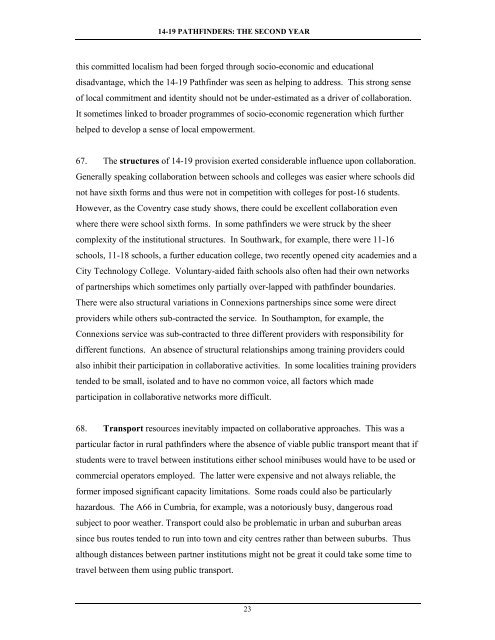Collaborative Approaches to 14-19 Provision - Communities and ...
Collaborative Approaches to 14-19 Provision - Communities and ...
Collaborative Approaches to 14-19 Provision - Communities and ...
- No tags were found...
Create successful ePaper yourself
Turn your PDF publications into a flip-book with our unique Google optimized e-Paper software.
<strong>14</strong>-<strong>19</strong> PATHFINDERS: THE SECOND YEARthis committed localism had been forged through socio-economic <strong>and</strong> educationaldisadvantage, which the <strong>14</strong>-<strong>19</strong> Pathfinder was seen as helping <strong>to</strong> address. This strong senseof local commitment <strong>and</strong> identity should not be under-estimated as a driver of collaboration.It sometimes linked <strong>to</strong> broader programmes of socio-economic regeneration which furtherhelped <strong>to</strong> develop a sense of local empowerment.67. The structures of <strong>14</strong>-<strong>19</strong> provision exerted considerable influence upon collaboration.Generally speaking collaboration between schools <strong>and</strong> colleges was easier where schools didnot have sixth forms <strong>and</strong> thus were not in competition with colleges for post-16 students.However, as the Coventry case study shows, there could be excellent collaboration evenwhere there were school sixth forms. In some pathfinders we were struck by the sheercomplexity of the institutional structures. In Southwark, for example, there were 11-16schools, 11-18 schools, a further education college, two recently opened city academies <strong>and</strong> aCity Technology College. Voluntary-aided faith schools also often had their own networksof partnerships which sometimes only partially over-lapped with pathfinder boundaries.There were also structural variations in Connexions partnerships since some were directproviders while others sub-contracted the service. In Southamp<strong>to</strong>n, for example, theConnexions service was sub-contracted <strong>to</strong> three different providers with responsibility fordifferent functions. An absence of structural relationships among training providers couldalso inhibit their participation in collaborative activities. In some localities training providerstended <strong>to</strong> be small, isolated <strong>and</strong> <strong>to</strong> have no common voice, all fac<strong>to</strong>rs which madeparticipation in collaborative networks more difficult.68. Transport resources inevitably impacted on collaborative approaches. This was aparticular fac<strong>to</strong>r in rural pathfinders where the absence of viable public transport meant that ifstudents were <strong>to</strong> travel between institutions either school minibuses would have <strong>to</strong> be used orcommercial opera<strong>to</strong>rs employed. The latter were expensive <strong>and</strong> not always reliable, theformer imposed significant capacity limitations. Some roads could also be particularlyhazardous. The A66 in Cumbria, for example, was a no<strong>to</strong>riously busy, dangerous roadsubject <strong>to</strong> poor weather. Transport could also be problematic in urban <strong>and</strong> suburban areassince bus routes tended <strong>to</strong> run in<strong>to</strong> <strong>to</strong>wn <strong>and</strong> city centres rather than between suburbs. Thusalthough distances between partner institutions might not be great it could take some time <strong>to</strong>travel between them using public transport.23
















